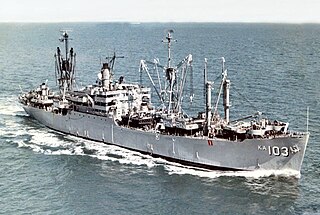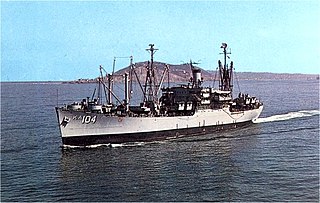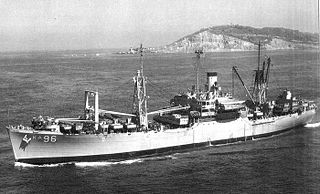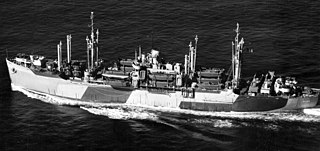
USS St. Louis (AKA-116/LKA-116), a Charleston class amphibious cargo ship, was the sixth US ship to bear the name. She served as a commissioned ship for 22 years and 11 months.

Amphibious cargo ships were U.S. Navy ships designed specifically to carry troops, heavy equipment and supplies in support of amphibious assaults, and to provide naval gunfire support during those assaults. A total of 108 of these ships were built between 1943 and 1945—which worked out to an average of one ship every eight days. Six additional AKAs, featuring new and improved designs, were built in later years. They were originally called Attack Cargo Ships and designated AKA. In 1969, they were renamed as Amphibious Cargo Ships and redesignated LKA.

USS Vermilion (AKA-107/LKA-107), was a Tolland-class attack cargo ship of the United States Navy, named after a parish in southern Louisiana and a county in eastern Illinois. She served as a commissioned ship for 25 years and 9 months.

USS Algol (AKA-54) was an Andromeda-class attack cargo ship. She was the first ship of the United States Navy by this name, after Algol, a fixed star in the constellation Perseus. Algol served as a commissioned ship for 22 years and 1 month.

USS Rankin (AKA-103/LKA-103) was a Tolland-class attack cargo ship in service with the United States Navy from 1945 to 1947 and again from 1952 to 1971. She was finally sunk as an artificial reef in 1988.

USS Skagit (AKA-105/LKA-105) was a Tolland-class attack cargo ship in service with the United States Navy from 1945 to 1949 and from 1950 to 1969. She was scrapped in 1974.

USS Seminole (AKA-104/LKA-104) was a Tolland-class attack cargo ship in service with the United States Navy from 1945 to 1970. She was scrapped in 1977.

USS Washburn (AKA-108) was a Tolland-class attack cargo ship in service with the United States Navy from 1945 to 1970 She was scrapped in 1980.

USS Tulare (AKA-112/LKA-112) was a Tulare-class attack cargo ship in service with the United States Navy from 1956 to 1986. She was sold for scrap in 2011.

USS Durham (LKA-114) was a Charleston-class amphibious cargo ship in service with the United States Navy from 1969 to 1994. She was sunk as a target in August 2020.

USS Mobile (AKA-115/LKA-115) was a Charleston class amphibious cargo ship named after the city of Mobile, Alabama. She was the fourth U.S. Navy ship to bear that name. She served as a commissioned ship for 24 years and 4 months. LKAs had the distinction of being the only ships in the "Gator Navy" that were not flat bottom. They would drop anchor several hundred yards offshore and use their Mike 8s (LCM-8) and Mike 6s (LCM-6) to ferry in the Marines and their equipment.

USS Mathews (AKA-96) was an Andromeda-class attack cargo ship named after Mathews County, Virginia. She served as a commissioned ship for 18 years and 8 months.

USS Winston (AKA-94/LKA-94) was an Andromeda-class attack cargo ship in service with the United States Navy from 1945 to 1957 and from 1961 to 1969. She was scrapped in 1979.

USS Yancey (AKA-93/LKA-93) was an Andromeda-class attack cargo ship built by the Moore Dry Dock Company of Oakland, California for the United States Navy during World War II. The ship was named in honor of Yancey County, North Carolina.

USS Arneb (AKA-56/LKA-56) was an Andromeda-class attack cargo ship named after Arneb, the brightest star in the southern constellation Lepus. She served as a commissioned ship for 27 years and 3 months, the longest time in commission of any AKA.

USS Muliphen (AKA-61/LKA-61) was an Andromeda-class attack cargo ship in service with the United States Navy from 1944 to 1970. She was sunk as an artificial reef in 1989.

USS Matar (AK-119) was a Crater-class cargo ship, converted from a Liberty Ship, commissioned by the US Navy for service in World War II. She was first named after Napoleon B. Broward, an American river pilot, captain, and politician; he was elected as the 19th Governor of the US state of Florida. She was renamed and commissioned after Matar, a binary star in the constellation of Pegasus. She was responsible for delivering troops, goods and equipment to locations in the war zone.

USS Magoffin (APA/LPA-199) was a Haskell-class attack transport in service with the United States Navy from 1944 to 1946 and from 1950 to 1968. She was scrapped in 1980.

USS Menard (APA-201) was a Haskell-class attack transport that saw service with the US Navy in World War II, the Korean War and Vietnam War.

USS Navarro (APA/LPA-215) was a Haskell-class attack transport of the US Navy. She was of the VC2-S-AP5 Victory ship design type that saw service in World War II and the Vietnam War. Navarro was named after Navarro County, Texas.



















